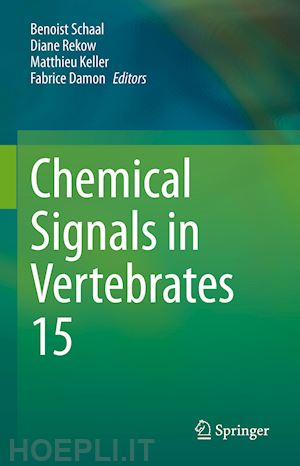

Questo prodotto usufruisce delle SPEDIZIONI GRATIS
selezionando l'opzione Corriere Veloce in fase di ordine.
Pagabile anche con Carta della cultura giovani e del merito, 18App Bonus Cultura e Carta del Docente
The 15th Meeting on Chemical Signals in Vertebrates (CSiV) reunited participants from 20 countries from 5 continents who "electronically commuted" to Dijon, France, during three days (3-5 November 2021). This virtual meeting was a great opportunity to share information on how amphibians, reptiles, birds, and mammals communicate through chemosignals and integrate their environment through chemical cues. Scientists from varied disciplines ranging from biology and psychology to chemistry and biostatistics attended the meeting to share their research on how vertebrates produce and release chemical cues and signals, how they detect, discriminate, process, and interpret them; how they respond to them behaviorally, physiologically, and/or neurally in adaptive ways; how the typical or atypical environment modulates such chemocommunication loops, and chemoreception in general.
In total, this 2021 CSiV meeting presented important new findings, representative of the growing points in the rapidly expanding field of research on chemocommunication among vertebrates. As appreciated by D Müller-Schwarze (a well-known pioneer in the field and the founding father of the book series in question) in his foreword to the meeting, “Our field has broadened to new horizons: besides multicomponent cues, we now learn about multisource and multifunction chemical signals. The range of study animals and settings has become richer, and we have learned enough that practical applications are becoming realistic.” This proceedings documents key presentations from this virtual conference.











Il sito utilizza cookie ed altri strumenti di tracciamento che raccolgono informazioni dal dispositivo dell’utente. Oltre ai cookie tecnici ed analitici aggregati, strettamente necessari per il funzionamento di questo sito web, previo consenso dell’utente possono essere installati cookie di profilazione e marketing e cookie dei social media. Cliccando su “Accetto tutti i cookie” saranno attivate tutte le categorie di cookie. Per accettare solo deterninate categorie di cookie, cliccare invece su “Impostazioni cookie”. Chiudendo il banner o continuando a navigare saranno installati solo cookie tecnici. Per maggiori dettagli, consultare la Cookie Policy.